Ultrasonic flow meters, such as those offered by HKT LORA, are versatile instruments used across various industries, including chemical, power, metallurgy, and water resource management. Their ability to provide non-invasive, accurate flow measurements makes them suitable for a range of applications. This article explores what are the applications of an ultrasonic flow meter, highlighting how our HKT LORA ultrasonic flow meters can enhance operational efficiency and safety.
Applications in the Chemical Industry
One key application of an ultrasonic flow meter is in the chemical industry, where they are used to measure corrosive fluids, such as acids and alkalis. In large-diameter pipelines, the non-contact measurement capabilities of HKT LORA ultrasonic flow meters help prevent damage to the equipment and ensure accurate readings.
Implementation Steps for Chemical Applications
To effectively utilize ultrasonic flow meters in the chemical sector, it is essential to select sensors based on the pipe material, diameter, and properties of the medium being measured. For corrosive fluids, ensure that the ultrasonic sensors are compatible and can withstand chemical exposure. Integrating the flow meters with existing control systems allows for real-time monitoring, enabling immediate adjustments based on flow data.
Applications in Power Generation
In the power generation sector, HKT LORA ultrasonic flow meters are important for monitoring the flow of various fluids, including steam and cooling water. These measurements help ensure efficient operation in power plants by providing accurate flow data that is essential for optimizing energy use.
Implementation Steps for Power Generation
To implement ultrasonic flow meters in power generation, choose the appropriate model based on specific fluid characteristics, such as temperature and pressure. Integrating the meters with the plant’s management systems facilitates continuous monitoring and data analysis, improving overall operational efficiency.
Applications in the Metallurgy Industry
HKT LORA ultrasonic flow meters are also used in the metallurgy industry for monitoring the flow of molten metals and other fluids involved in metal processing. Their non-invasive measurement technique minimizes contamination and maintains the integrity of the materials.
Implementation Steps for Metallurgy
When selecting ultrasonic flow meters for metallurgy, it is important to choose equipment that can handle high temperatures and the specific properties of molten metals. Connecting the flow meters to operational control systems allows for real-time monitoring and adjustments, ensuring optimal processing conditions.
Heat Metering in Heating Systems
In district heating networks, HKT LORA ultrasonic flow meters are essential for measuring hot water flow, which is important for billing and system optimization. By providing accurate flow data, these meters support better management of heating resources.
Implementation Steps for Heating Systems
To effectively use ultrasonic flow meters in heating systems, combine them with temperature sensors to accurately calculate heat energy. Transmitting the collected data to management systems allows for efficient parameter adjustments, ensuring optimal operation of heating systems.
Conclusion
In summary, understanding what are the applications of an ultrasonic flow meter reveals their important roles in various industries, including chemical, power, metallurgy, and water resource management. The HKT LORA ultrasonic flow meter provides accurate, non-invasive measurements that are useful for optimizing processes and ensuring safety. By selecting appropriate sensors and integrating them with control systems, organizations can effectively utilize our HKT LORA ultrasonic flow meters to improve operational efficiency.



